
Hey y’all! Thanks so much for stopping by. My name is Laura and I am an Elementary School Counselor turned Curriculum Writer. At my precious school in Nashville, TN, 97% of my students were living in …
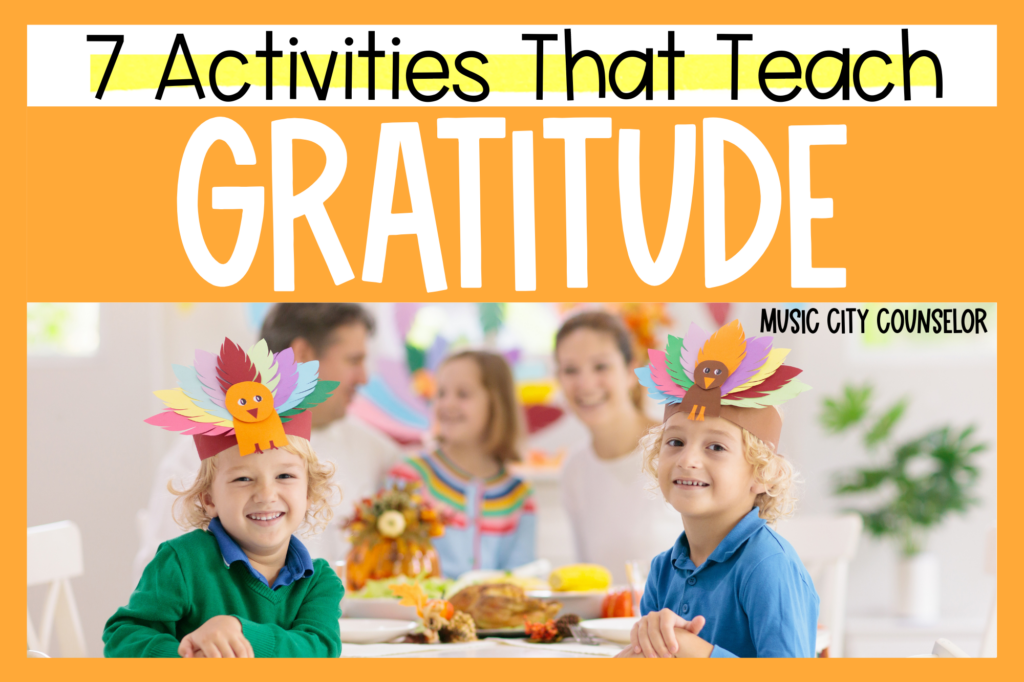
Thanksgiving is my favorite holiday to weave in social-emotional learning. Gratitude is a valuable quality to nurture year-round, but the holiday season is the perfect time to teach it.
So, what is gratitude, anyway? Here’s the definition that I use:

Helping kids develop a sense of gratitude is a powerful way to build their emotional well-being and strengthen their connections with others. It provides students with a way to recognize the positive aspects of their lives and express appreciation for them.
In fact, gratitude is often considered the “secret” to mental health because it shifts our focus from what we lack to what we have, promoting a positive mindset. When we regularly practice gratitude, we train our brains to notice the good around us, which can reduce stress, increase happiness, and improve overall emotional resilience. Gratitude helps balance negative emotions, like anxiety and frustration, by fostering a sense of contentment and appreciation. This positive outlook not only enhances our mood, but also strengthens our relationships with others.
Read on for 7 simple and engaging activity ideas, book recommendations, and resources to bring a spirit of gratitude into your classroom, school, and community.
Encourage students to write or draw something they’re thankful for each day. This simple habit helps them focus on positive moments and build appreciation over time. This is a great exercise for morning meeting, the start of counseling sessions and lessons, lunch bunches, and more!
Start or end your lesson or counseling session by having students sit in a circle and take turns sharing something or someone they’re grateful for. This simple activity fosters a sense of community and let’s kids hear what others appreciate. Students may even mention each other, their teacher, or their school counselor – which will surely warm their hearts!
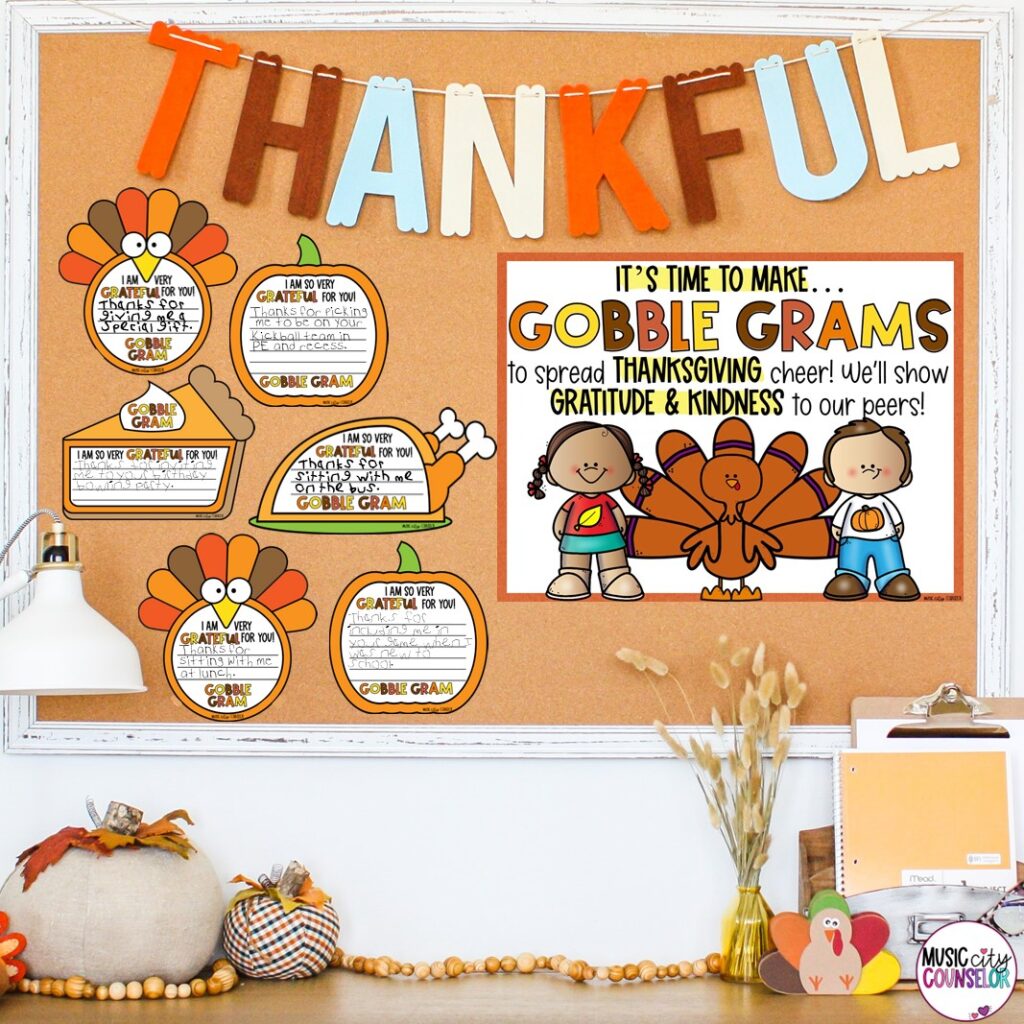
We could ALL use a morale boost these days, am I right? Gobble Grams are my favorite way to spread gratitude around my school community during the Thanksgiving season!
Students, teachers, and parents send them to each other to share the love! The cute festive templates say, “I am very grateful for you!” and students/teachers/parents write a message of gratitude to someone they care about. Schools have used Gobble Grams as fundraisers, team-building exercises among faculty, to build classroom community, and more. Just a simple message of gratitude can really go a long way!
Partner with teachers to create “Thank You Kits” for community helpers like firefighters, police officers, teachers, school bus drivers, or healthcare workers. Students can work together to assemble small kits with handwritten thank-you notes, drawings, or simple treats to show appreciation for the hard work these individuals do every day.
This simple but meaningful project teaches kids to recognize and value the people who make their community a better place, fostering gratitude for others’ contributions. And, by actively preparing and delivering the kits, students experience the joy of giving back.

If you know me, you know that I LOVE incorporating story books into my counseling programming! Here are 6 of my favorites that teach gratitude:
(Amazon Affiliate Links)
Here are reviews of a few of my favorites!
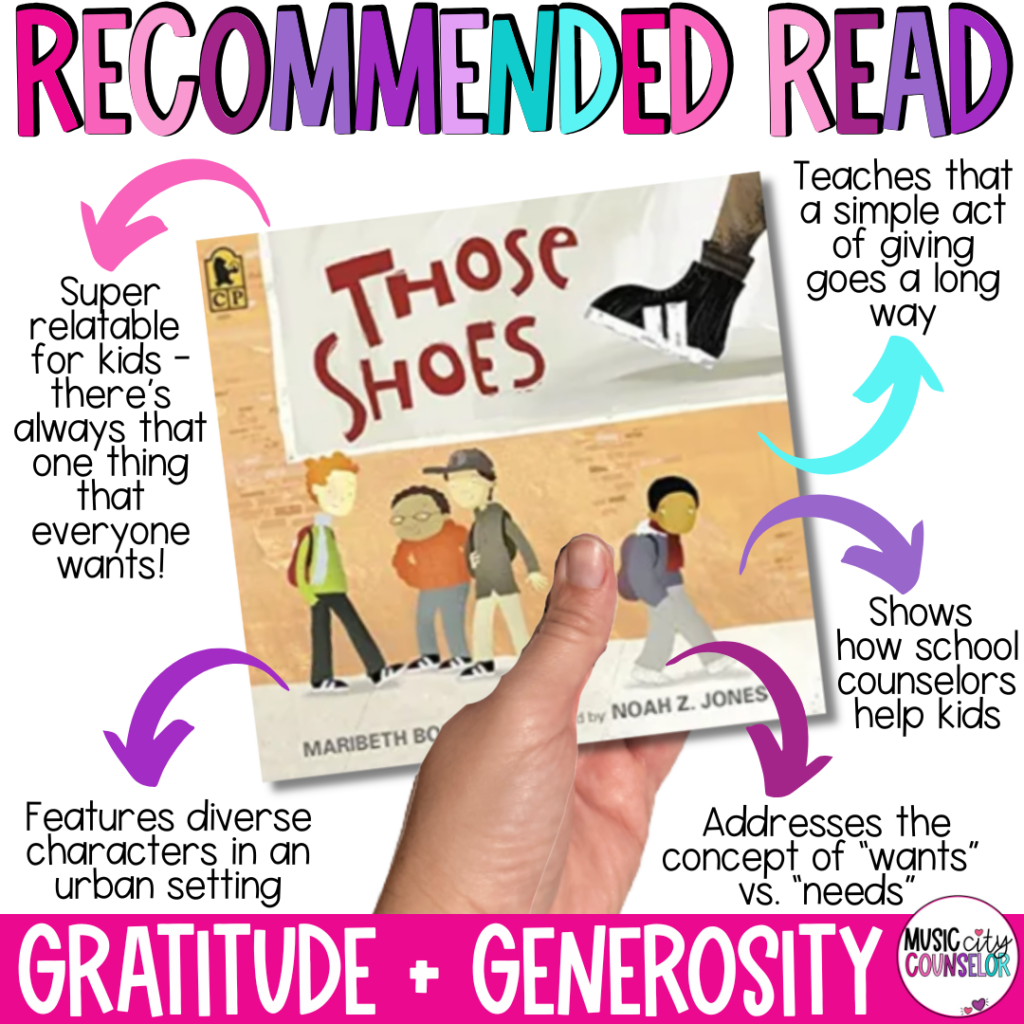
“Those Shoes” tells the story of Jeremy, a little boy who desperately wants a pair of “those shoes” that all of the kids at school (besides him, of course) are wearing. But, his grandma just can’t afford a pair of these expensive, popular shoes. Instead, Jeremy wears an embarrassing pair of “Mr. Alfrey shoes” that his school counselor gave him when his were torn. One day, Grandma offers to take Jeremy to a thrift store to see if they can find a second-hand pair of “those shoes,” and to his delight, they do! Even though they are too small for his feet, Jeremy proudly and stubbornly wears “those shoes” just so he can fit in with the crowd.
But, after a few painful days in too-small shoes, Jeremy notices that his friend Antonio, whose feet are smaller than his, is wearing torn and taped shoes. Antonio was the only friend at school that didn’t make fun of Jeremy’s “Mr. Alfrey shoes.” As hard as it was to give up his pair of the special shoes, Jeremy chose to surprise Antonio with them as a special gift.
This is a powerful and relatable story about friendship, compassion, kindness, gratitude, generosity, and the difference between wants and needs. It is a perfect message for the holiday season to help children understand that it is even more beautiful to give than it is to receive!
Be sure to check out my companion lesson to go along with this story!
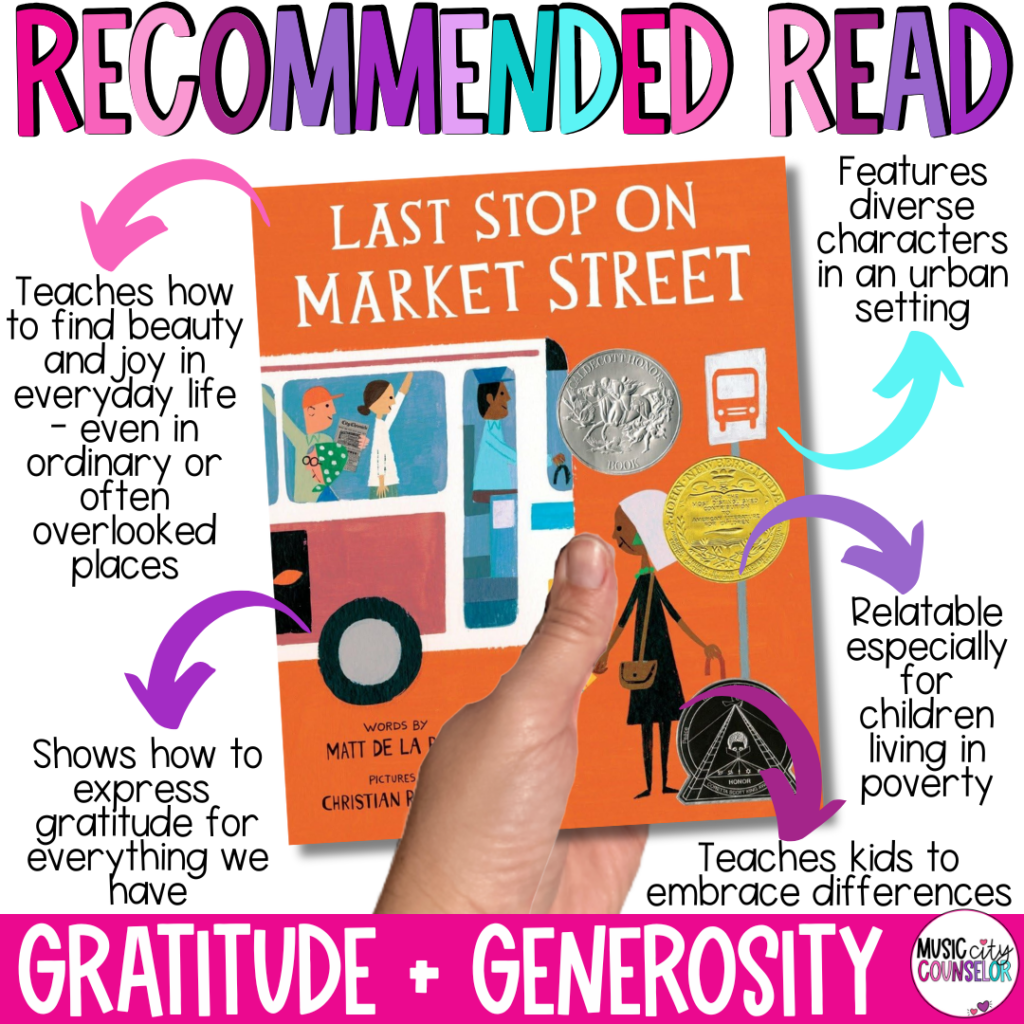
My son received “Last Stop on Market Street” from Dolly Parton’s Imagination Library, and each time we read it together, I enjoy it even more!
It tells the story of CJ and his grandma taking a bus ride through their city. On their ride, CJ notices some things he perceives as unfair or sad, and asks Nana about them. Why doesn’t his family have a car? Why can’t the blind man see? Why doesn’t he have an iPod to listen to music on? And with each question, Nana spins them in a positive way for CJ and helps him see the beauty around him. His family doesn’t have a car – but they have a big bus with a fire-breathing dragon on it and a friendly bus driver. The blind man may not be able to see, but he can experience the world through his other senses. And CJ may not have an iPod to listen to, but he can enjoy the live music being played on the bus, just for him and the other passengers.
This is a beautiful story about the importance of a positive attitude and expressing gratitude for all that we have. It teaches kids to find beauty, gratitude, and community in everyday life, even in places that might seem ordinary or overlooked. The story encourages readers to look beyond appearances, embrace differences, and recognize the value in all people and places. I absolutely love how this book incorporates so many diverse elements that most other stories do not, including African American main characters, disability, poverty, and the realities of urban life.
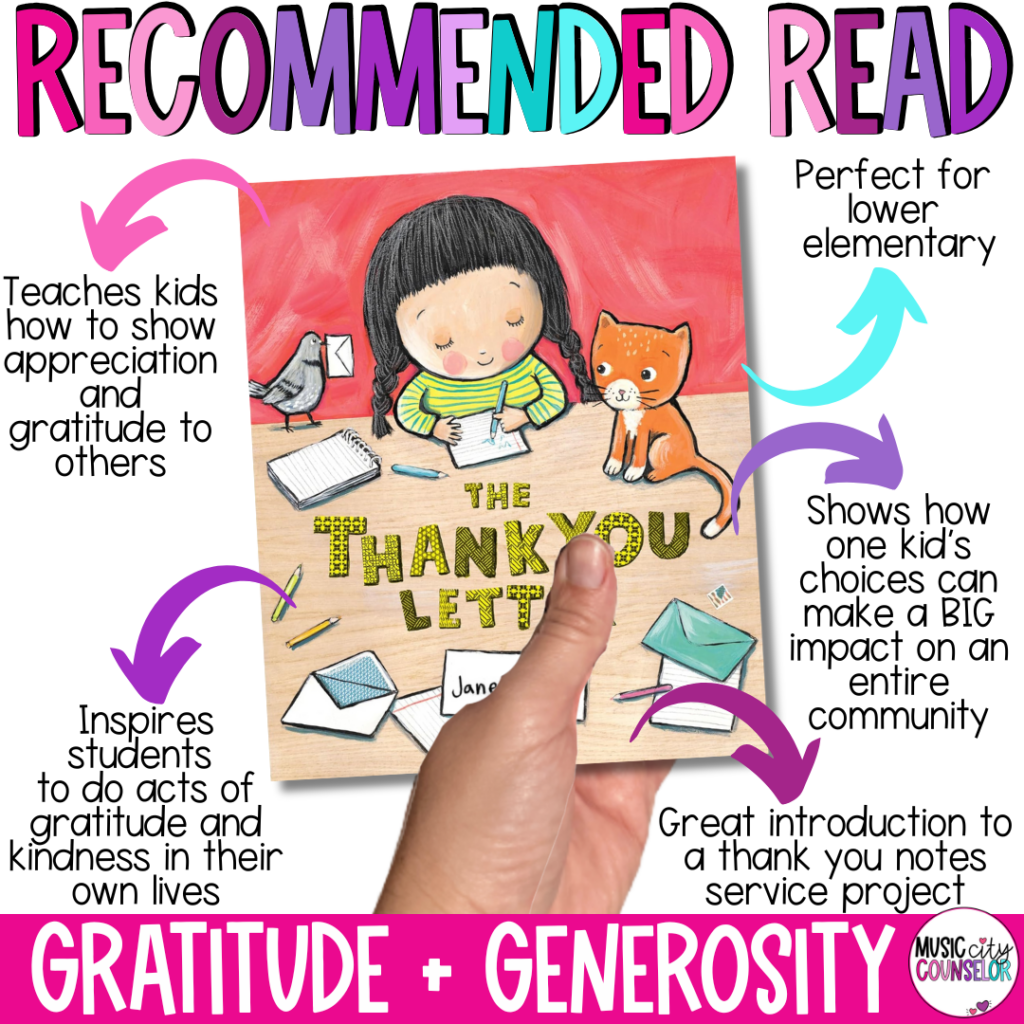
In “The Thank You Letter,” Grace’s birthday was coming up, and she wrote a LONG list of gifts she would like. After her birthday party, Grace wrote cute and funny thank you notes to all of her friends and family members for the special gifts they brought her. But, Grace didn’t stop there! She decided to write a thank you note to the lady in the thrift store, her teacher, her cat, her dog, the sky, and more! Grace’s thank you notes could be found all over town and brought joy to her entire community. To show gratitude back to Grace, community members wrote love notes back to her.
This is a super sweet read for lower elementary students that would be the perfect introduction to writing thank you/gratitude notes to school staff, family members, friends, and community helpers. It’s inspirational, memorable, and really shows kids that small acts of kindness can make a big impact!
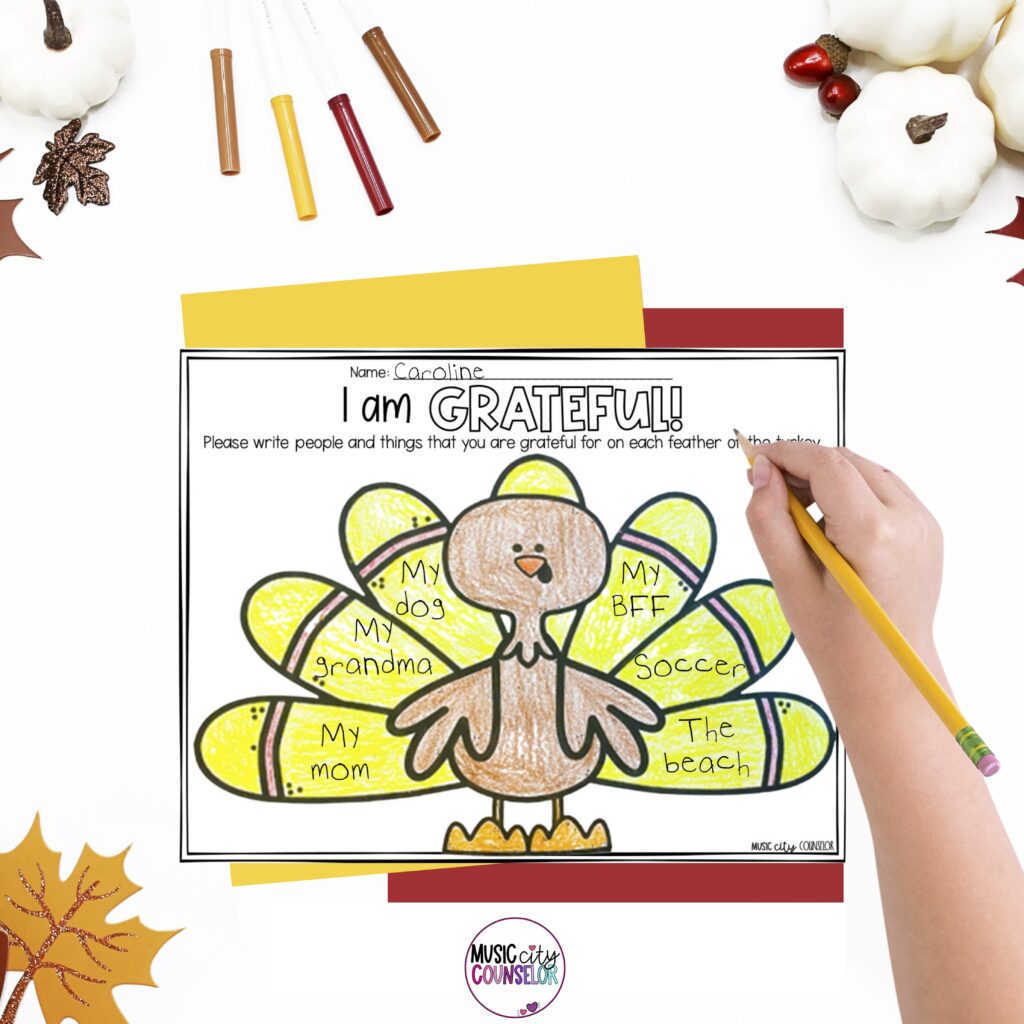
Making grateful turkeys is a Thanksgiving classic! This activity let’s students decorate a cute turkey and write one thing, person, or place they are grateful for on each feather. I included a digital version for our techie friends, too!
Lead students in short, mindful moments where they can pause, breathe, and think about one thing they are grateful for in that moment. Being present in the “here and now” helps us focus on the beauty around us and the many things to be thankful for!
I hope this post offered you practical tips, tricks, and resources to spread gratitude in your classroom, school, and community. What are your favorite ways to teach gratitude to your students? Please comment below, I’d love to hear from you!

| Cookie | Duration | Description |
|---|---|---|
| cookielawinfo-checkbox-analytics | 11 months | This cookie is set by GDPR Cookie Consent plugin. The cookie is used to store the user consent for the cookies in the category "Analytics". |
| cookielawinfo-checkbox-functional | 11 months | The cookie is set by GDPR cookie consent to record the user consent for the cookies in the category "Functional". |
| cookielawinfo-checkbox-necessary | 11 months | This cookie is set by GDPR Cookie Consent plugin. The cookies is used to store the user consent for the cookies in the category "Necessary". |
| cookielawinfo-checkbox-others | 11 months | This cookie is set by GDPR Cookie Consent plugin. The cookie is used to store the user consent for the cookies in the category "Other. |
| cookielawinfo-checkbox-performance | 11 months | This cookie is set by GDPR Cookie Consent plugin. The cookie is used to store the user consent for the cookies in the category "Performance". |
| viewed_cookie_policy | 11 months | The cookie is set by the GDPR Cookie Consent plugin and is used to store whether or not user has consented to the use of cookies. It does not store any personal data. |